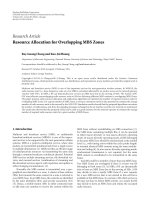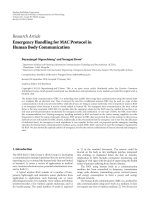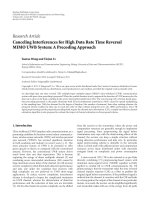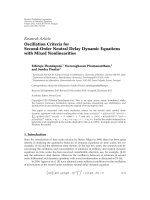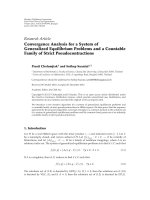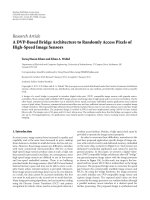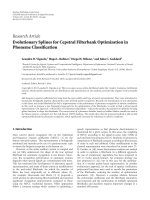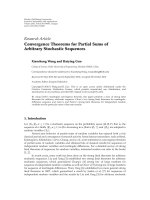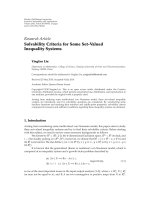Báo cáo hóa học: " Research Article Regularity Criterion for Weak Solutions to the Navier-Stokes Equations in Terms of the Gradient of the Pressure" docx
Bạn đang xem bản rút gọn của tài liệu. Xem và tải ngay bản đầy đủ của tài liệu tại đây (466.2 KB, 6 trang )
Hindawi Publishing Corporation
Journal of Inequalities and Applications
Volume 2008, Article ID 412678, 6 pages
doi:10.1155/2008/412678
Research Article
Regularity Criterion for Weak Solutions
to the Navier-Stokes Equations in Terms of
the Gradient of the Pressure
Jishan Fan
1
and Tohru Ozawa
2
1
Department of Applied Mathematics, Nanjing Forestry University, Nanjing 210037, China
2
Department of Applied Physics, Waseda University, Tokyo 169-8555, Japan
Correspondence should be addressed to Tohru Ozawa,
Received 26 June 2008; Accepted 14 October 2008
Recommended by Michel Chipot
We prove a regularity criterion ∇π ∈ L
2/3
0,T;BMO for weak solutions to the Navier-Stokes
equations in three-space dimensions. This improves the available result with L
2/3
0,T; L
∞
.
Copyright q 2008 J. Fan and T. Ozawa. This is an open access article distributed under the Creative
Commons Attribution License, which permits unrestricted use, distribution, and reproduction in
any medium, provided the original work is properly cited.
1. Introduction
We study the regularity condition of weak solutions to the Navier-Stokes equations
u
t
− Δu u·∇u ∇π 0, 1.1
div u 0, in 0,T × R
3
, 1.2
u|
t0
u
0
x,x∈ R
3
. 1.3
Here, u is the unknown velocity vector and π is the unknown scalar pressure.
For u
0
∈ L
2
R
3
with div u
0
0inR
3
, Leray 1 constructed global weak solutions. The
smoothness of Leray’s weak solutions is unknown. While the existence of regular solutions is
still an open problem, there are many interesting sufficient conditions which guarantee that
a given weak solution is smooth. A well-known condition states that if
u ∈ L
r
0,T; L
s
R
3
with
2
r
3
s
1, 3 ≤ s ≤∞, 1.4
2 Journal of Inequalities and Applications
then the solution u is actually regular 2–8. A similar condition
ω : curl u ∈ L
r
0,T; L
s
R
3
, with
2
r
3
s
2,
3
2
≤ s ≤∞, 1.5
also implies the regularity as shown by Beir
˜
ao da Veiga 9.
As regards 1.4 and 1.5 for s ∞, Kozono et al. made an improvement to the
following condition:
u ∈ L
2
0,T;
˙
B
0
∞,∞
R
3
, 1.6
or
ω ∈ L
1
0,T;
˙
B
0
∞,∞
R
3
, 1.7
where
˙
B
0
∞,∞
is the homogeneous Besov space. On the other hand, Chae and Lee 10 proposed
another regularity criterion in terms of the pressure. They showed that if the pressure π
satisfies
π ∈ L
r
0,T; L
s
R
3
with
2
r
3
s
< 2,
3
2
<s≤∞, 1.8
then u is smooth. Berselli and Galdi 11 have extended the range of r and s to 2/r 3/s 2
and 3/2 <s≤∞. When s ∞, Chen and Zhang 12also see Fan et al. 13 refined it to the
following condition:
π ∈ L
1
0,T;
˙
B
0
∞,∞
R
3
. 1.9
Zhou 14see also Struwe 15 proposed the following criterion in terms of the gradient of
the pressure:
∇π ∈ L
r
0,T; L
s
R
3
with
2
r
3
s
3, 1 <s≤∞. 1.10
The aim of this paper is to refine 1.10 when s ∞. We will use the following
interpolation inequality:
u
2
L
2p
R
n
≤ Cu
L
p
R
n
u
BMO
, 1 ≤ p<∞, 1.11
which follows from the bilinear estimates
fg
L
p
≤ Cf
L
p
g
BMO
g
L
p
f
BMO
, 1 ≤ p<∞, 1.12
due to Kozono and Taniuchi 16. Here, BMO is the space of functions of bounded mean
oscillations.
J. Fan and T. Ozawa 3
Definition 1.1. Let u
0
∈ L
2
R
3
with div u
0
0inR
3
. The function u is called a Leray weak
solution of 1.1–1.3 in 0,T if u satisfies the following properties.
1 u ∈ L
∞
0,T; L
2
∩ L
2
0,T; H
1
.
2 Equation 1.1 and 1.2 hold in the distributional sense, and
ut −→ u
0
weakly in L
2
as t −→ 0. 1.13
3 The energy inequality is
ut
2
L
2
2
t
0
∇us
2
L
2
ds ≤u
0
2
L
2
, for any t ∈ 0,T. 1.14
Our main result reads as follows.
Theorem 1.2. Let u
0
∈ L
2
∩ L
4
R
3
with div u
0
0 in R
3
. Suppose that u is a Leray weak solution
of 1.1–1.3 in 0,T. If the gradient of the pressure satisfies the condition
∇π ∈ L
2/3
0,T;BMO, 1.15
then u is smooth in 0,T.
Remark 1.3. If the interpolation inequality
u
2
L
2p
R
n
≤ Cu
L
p
u
˙
B
0
∞,∞
1.16
is true, then as in the argument below, 1.15 may be improved to the following condition:
∇π ∈ L
2/3
0,T;
˙
B
0
∞,∞
. 1.17
Remark 1.4. Inequality 1.11 plays an important role in our proof. Chen and Zhu 17
extended 1.11 to the following inequality:
u
L
q
≤ Cu
r/q
L
r
u
1−r/q
BMO
, 1 ≤ r<q<∞, 1.18
and used 1.18 to obtain 1.12. Kozono and Wadade 18 give another proof of 1.18. Here,
we give an elementary and short proof of 1.18 by 1.11.
For given 1 ≤ r<q<∞, there exists a positive integer n and θ ∈ 0, 1 such that
r<q<2
n
r and 1/q θ · 1/r1 − θ · 1/2
n
rθ 1 − θ/2
n
· 1/r.BytheH
¨
older
inequality, we have
u
L
q
≤u
θ
L
r
u
1−θ
L
2
n
r
. 1.19
4 Journal of Inequalities and Applications
Using 1.11 for p 2
n−1
r,2
n−2
r, , r, ntimes and plugging them into 1.6,wefind
that
u
L
q
≤ Cu
θ1−θ/2
n
L
r
u
1−θ1/21/2
2
···1/2
n
BMO
Cu
θ1−θ/2
n
L
r
u
1−1/2
n
1−θ
BMO
Cu
r/q
L
r
u
1−r/q
BMO
,
1.20
which proves 1.18 .
Remark 1.5. From Remark 1.4, we know that if 1.16 holds true, then we have
u
L
q
≤ Cu
r/q
L
r
u
1−r/q
˙
B
0
∞,∞
, 1 ≤ r<q<∞. 1.21
2. Proof of Theorem 1.2
This section is devoted to the proof of Theorem 1.2. First, we recall the following result
according to Giga 5.
Proposition 2.1 see 5. Suppose u
0
∈ L
s
R
3
,s≥ 3; then there exists T and a unique classical
solution u ∈ L
∞
∩ C0,T; L
s
. Moreover, let 0,T
∗
be the maximal interval such that u solves
1.1–1.3 in C0,T
∗
; L
s
,s>3. Then, for any t ∈ 0,T
∗
,
ut
L
s
≥
C
T
∗
− t
s−3/2s
2.1
with the constant C independent of T
∗
and s.
Next, we derive a priori estimates for smooth solutions of 1.1–1.3. To this end,
multiplying 1.1 by |u|
2
u, integrating by parts, and using 1.2, 1.11 for p 2, we see that
1
4
d
dt
u
4
L
4
|∇u|
2
|u|
2
dx
1
4
|∇|u|
2
|
2
dx −
∇π ·|u|
2
udx ≤∇π
L
4
u
3
L
4
≤ C∇π
1/2
L
2
∇π
1/2
BMO
u
3
L
4
≤ Cu∇u
1/2
L
2
∇π
1/2
BMO
u
3
L
4
≤
1
2
|u ·∇u|
2
L
2
C∇π
2/3
BMO
u
4
L
4
,
2.2
which yields
u
L
4
≤u
0
L
4
exp
C
T
0
∇π
2/3
BMO
dt
, 2.3
J. Fan and T. Ozawa 5
by Gronwall’s inequality. Here, we have used the estimate
∇π
L
2
≤ Cu ·∇u
L
2
. 2.4
Now, we are in a position to complete the proof of Theorem 1.2.FromProposition 2.1,
it follows that there exists T
∗
> 0 and the smooth solution v of 1.1–1.3 satisfies
vt ∈ L
∞
∩ C0,T
∗
; L
4
,v0u
0
. 2.5
Since the weak solution u satisfies the energy inequality, we may apply Serrin’s
uniqueness criterion 19 to conclude that
u ≡ v on 0,T
∗
. 2.6
Thus, it is sufficient to show that T
∗
T. Suppose that T
∗
<T. Without loss of
generality, we may assume that T
∗
is the maximal existence time for vt.ByProposition 2.1
again, we find that
ut
L
4
≥
C
T
∗
− t
1/8
for any t ∈ 0,T
∗
. 2.7
On the other hand, from 2.3, we know that
sup
0≤t≤T
∗
ut
L
4
≤u
0
L
4
exp
C
T
0
∇π
2/3
BMO
dt
, 2.8
which contradicts with 2.7.Thus,T
∗
T.
This completes the proof.
Acknowledgment
This work is supported by NSFC Grant no. 10301014.
References
1 J. Leray, “Sur le mouvement d’un liquide visqueux emplissant l’espace,” Acta Mathematica, vol. 63,
no. 1, pp. 193–248, 1934.
2 J. Serrin, “On the interior regularity of weak solutions of the Navier-Stokes equations,” Archive for
Rational Mechanics and Analysis, vol. 9, no. 1, pp. 187–195, 1962.
3 T. Ohyama, “Interior regularity of weak solutions of the time-dependent Navier-Stokes equation,”
Proceedings of the Japan Academy, vol. 36, no. 5, pp. 273–277, 1960.
4 E. B. Fabes, B. F. Jones, and N. M. Riviere, “The initial value problem for the Navier-Stokes equations
with data in L
p
,” Archive for Rational Mechanics and Analysis, vol. 45, no. 3, pp. 222–240, 1972.
5 Y. Giga, “Solutions for semilinear parabolic equations in L
p
and regularity of weak solutions of the
Navier-Stokes system,” Journal of Differential Equations, vol. 62, no. 2, pp. 186–212, 1986.
6 M. Struwe, “On partial regularity results for the Navier-Stokes equations,” Communications on Pure
and Applied Mathematics, vol. 41, no. 4, pp. 437–458, 1988.
6 Journal of Inequalities and Applications
7 H. Sohr and W. von Wahl, “On the regularity of the pressure of weak solutions of Navier-Stokes
equations,” Archiv der Mathematik, vol. 46, no. 5, pp. 428–439, 1986.
8 L. Iskauriaza, G. A. Ser
¨
egin, and V. Shverak, “L
3,∞
-solutions of Navier-Stokes equations and
backward uniqueness,” Russian Mathematical Surveys, vol. 58, no. 2, pp. 211–250, 2003.
9 H. Beir
˜
ao da Veiga, “A new regularity class for the Navier-Stokes equations in
R
n
,” Chinese Annals of
Mathematics. Series B, vol. 16, no. 4, pp. 407–412, 1995.
10 D. Chae and J. Lee, “Regularity criterion in terms of pressure for the Navier-Stokes equations,”
Nonlinear Analysis: Theory, Methods & Applications, vol. 46, no. 5, pp. 727–735, 2001.
11 L. C. Berselli and G. P. Galdi, “Regularity criteria involving the pressure for the weak solutions to
the Navier-Stokes equations,” Proceedings of the American Mathematical Society, vol. 130, no. 12, pp.
3585–3595, 2002.
12 Q. Chen and Z. Zhang, “Regularity criterion via the pressure on weak solutions to the 3D Navier-
Stokes equations,” Proceedings of the American Mathematical Society, vol. 135, no. 6, pp. 1829–1837, 2007.
13 J. Fan, S. Jiang, and G. Ni, “On regularity criteria for the n-dimensional Navier-Stokes equations in
terms of the pressure,” Journal of Differential Equations, vol. 244, no. 11, pp. 2963–2979, 2008.
14 Y. Zhou, “On regularity criteria in terms of pressure for the Navier-Stokes equations in
R
3
,”
Proceedings of the American Mathematical Society, vol. 134, no. 1, pp. 149–156, 2006.
15 M. Struwe, “On a Serrin-type regularity criterion for the Navier-Stokes equations in terms of the
pressure,” Journal of Mathematical Fluid Mechanics, vol. 9, no. 2, pp. 235–242, 2007.
16 H. Kozono and Y. Taniuchi, “Bilinear estimates in BMO and the Navier-Stokes equations,”
Mathematische Zeitschrift, vol. 235, no. 1, pp. 173–194, 2000.
17 J. Chen and X. Zhu, “A note on BMO and its application,” Journal of Mathematical Analysis and
Applications, vol. 303, no. 2, pp. 696–698, 2005.
18 H. Kozono and H. Wadade, “Remarks on Gagliardo-Nirenberg type inequality with critical Sobolev
space and BMO,” Mathematische Zeitschrift, vol. 259, no. 4, pp. 935–950, 2008.
19 J. Serrin, “The initial value problem for the Navier-Stokes equations,” in Nonlinear Problems,R.E.
Langer, Ed., pp. 69–98, University of Wisconsin Press, Madison, Wis, USA, 1963.
